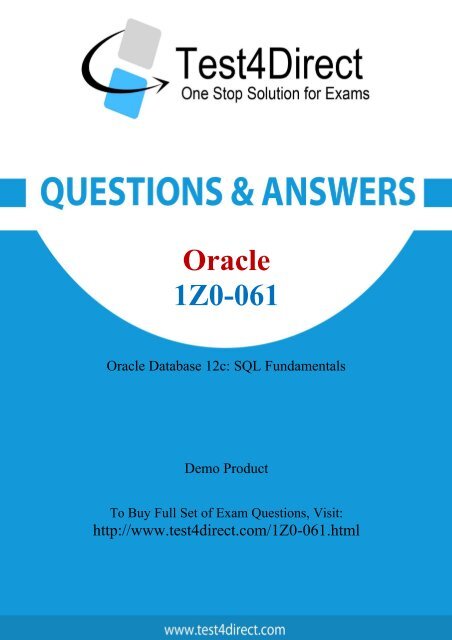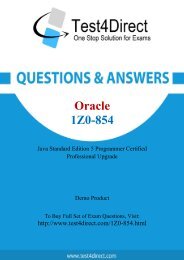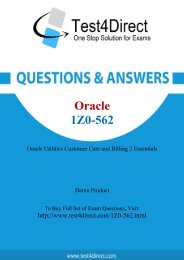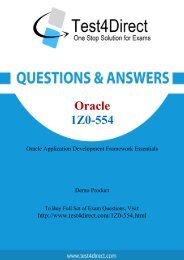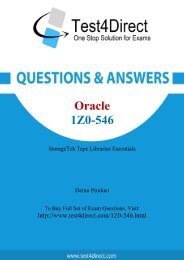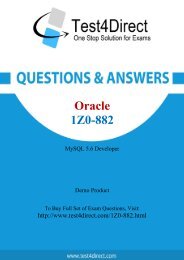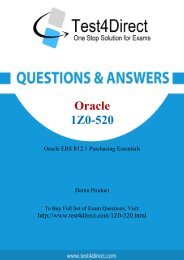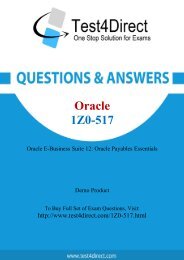Download 1Z0-061 BrainDumps to Success in career
Test4Direct provides latest PDF questions of Oracle 1Z0-061 exam. You have an opportunity to pass the Oracle 1Z0-061 exam in one go. Test4Direct is most accurate source to prepare Oracle 1Z0-061 exam as your success will become site’s responsibility after purchasing 1Z0-061 exam product. There are also lots of discounts and promotion offers that you can avail. Let’s try a free demo http://www.test4direct.com/1Z0-061.html
Test4Direct provides latest PDF questions of Oracle 1Z0-061 exam. You have an opportunity to pass the Oracle 1Z0-061 exam in one go. Test4Direct is most accurate source to prepare Oracle 1Z0-061 exam as your success will become site’s responsibility after purchasing 1Z0-061 exam product. There are also lots of discounts and promotion offers that you can avail. Let’s try a free demo http://www.test4direct.com/1Z0-061.html
You also want an ePaper? Increase the reach of your titles
YUMPU automatically turns print PDFs into web optimized ePapers that Google loves.
Oracle<br />
<strong>1Z0</strong>-<strong>061</strong><br />
Oracle Database 12c: SQL Fundamentals<br />
Demo Product<br />
To Buy Full Set of Exam Questions, Visit:<br />
http://www.test4direct.com/<strong>1Z0</strong>-<strong>061</strong>.html
Question: 1<br />
Evaluate the follow<strong>in</strong>g SQL statement:<br />
Which statement is true regard<strong>in</strong>g the outcome of the above query?<br />
A. It executes successfully and displays rows <strong>in</strong> the descend<strong>in</strong>g order of PROMO_CATEGORY.<br />
B. It produces an error because positional notation cannot be used <strong>in</strong> the order by clause with set<br />
opera<strong>to</strong>rs.<br />
C. It executes successfully but ignores the order by clause because it is not located at the end of the<br />
compound statement.<br />
D. It produces an error because the order by clause should appear only at the end of a compound<br />
query-that is, with the last select statement.<br />
Question: 2<br />
Answer: D<br />
View the Exhibit and exam<strong>in</strong>e the structure of the product, component, and PDT_COMP tables.<br />
In product table, PDTNO is the primary key.<br />
In component table, COMPNO is the primary key.<br />
In PDT_COMP table, SELECT pdtno, pdtname, compno, compname<br />
FROM product _____________ pdt_comp<br />
USING (pdtno) ____________ component USING (compno)<br />
WHERE compname IS NOT NULL;<br />
Which comb<strong>in</strong>ation of jo<strong>in</strong>s used <strong>in</strong> the blanks <strong>in</strong> the above query gives the correct output?
A. JOIN; JOIN<br />
B. FULL OUTER JOIN; FULL OUTER JOIN<br />
C. RIGHT OUTER JOIN; LEFT OUTER JOIN<br />
D. LEFT OUTER JOIN; RIGHT OUTER JOIN<br />
Answer: C<br />
Question: 3<br />
View the Exhibit for the structure of the student and faculty tables.<br />
You need <strong>to</strong> display the faculty name followed by the number of students handled by the faculty at<br />
the base location.<br />
Exam<strong>in</strong>e the follow<strong>in</strong>g two SQL statements:<br />
Which statement is true regard<strong>in</strong>g the outcome?<br />
A. Only statement 1 executes successfully and gives the required result.<br />
B. Only statement 2 executes successfully and gives the required result.<br />
C. Both statements 1 and 2 execute successfully and give different results.<br />
D. Both statements 1 and 2 execute successfully and give the same required result.
Answer: D<br />
Question: 4<br />
View the Exhibits and exam<strong>in</strong>e products and sales tables.<br />
You issue the follow<strong>in</strong>g query <strong>to</strong> display product name and the number of times the product has<br />
been sold:<br />
What happens when the above statement is executed?<br />
A. The statement executes successfully and produces the required output.<br />
B. The statement produces an error because item_cnt cannot be displayed <strong>in</strong> the outer query.<br />
C. The statement produces an error because a subquery <strong>in</strong> the from clause and outer-jo<strong>in</strong>s cannot be<br />
used <strong>to</strong>gether.<br />
D. The statement produces an error because the group by clause cannot be used <strong>in</strong> a subquery <strong>in</strong> the<br />
from clause.<br />
Question: 5<br />
Answer: A<br />
You want <strong>to</strong> create a table employees <strong>in</strong> which the values of columns EMPLOYEES_ID and LOGIN_ID
must be unique and not null. Which two SQL statements would create the required table?<br />
A. Option A<br />
B. Option B<br />
C. Option C<br />
D. Option D<br />
E. Option E<br />
F. Option F<br />
Answer: D,E
Question: 6<br />
View the Exhibit and exam<strong>in</strong>e the structure of the products table.<br />
Us<strong>in</strong>g the products table, you issue the follow<strong>in</strong>g query <strong>to</strong> generate the names, current list price, and<br />
discounted list price for all those products whose list price falls below $10 after a discount of 25% is<br />
applied on it.<br />
The query generates an error. What is the reason for the error?<br />
A. The parenthesis should be added <strong>to</strong> enclose the entire expression.<br />
B. The double quotation marks should be removed from the column alias.<br />
C. The column alias should be replaced with the expression <strong>in</strong> the where clause.<br />
D. The column alias should be put <strong>in</strong> uppercase and enclosed with<strong>in</strong> double quotation marks <strong>in</strong> the<br />
where clause.<br />
Question: 7<br />
Exam<strong>in</strong>e the structure proposed for the transactions table:<br />
Answer: C<br />
Which two statements are true regard<strong>in</strong>g the creation and s<strong>to</strong>rage of data <strong>in</strong> the above table<br />
structure?<br />
A. The CUST_STATUS column would give an error.<br />
B. The TRANS_VALIDITY column would give an error.
C. The CUST_STATUS column would s<strong>to</strong>re exactly one character.<br />
D. The CUST_CREDIT_LIMIT column would not be able <strong>to</strong> s<strong>to</strong>re decimal values.<br />
E. The TRANS_VALIDITY column would have a maximum size of one character.<br />
F. The TRANS_DATE column would be able <strong>to</strong> s<strong>to</strong>re day, month, century, year, hour, m<strong>in</strong>utes, seconds,<br />
and fractions of seconds<br />
Question: 8<br />
Question: 9<br />
Answer: B,C<br />
Explanation:<br />
VARCHAR2(size)Variable-length character data (A maximum size must be specified: m<strong>in</strong>imum size is<br />
1; maximum size is 4, 000.) CHAR [(size)] Fixed-length character data of length size bytes (Default and<br />
m<strong>in</strong>imum size is 1; maximum size is 2, 000.)<br />
NUMBER [(p, s)] Number hav<strong>in</strong>g precision p and scale s (Precision is the <strong>to</strong>tal number of decimal<br />
digits and scale is the number of digits <strong>to</strong> the right of the decimal po<strong>in</strong>t; precision can range from 1 <strong>to</strong><br />
38, and scale can range from –84 <strong>to</strong> 127.)<br />
DATE Date and time values <strong>to</strong> the nearest second between January 1, 4712 B.C., and December 31,<br />
9999 A.D.<br />
You need <strong>to</strong> create a table for a bank<strong>in</strong>g application. One of the columns <strong>in</strong> the table has the<br />
follow<strong>in</strong>g requirements:<br />
1) You want a column <strong>in</strong> the table <strong>to</strong> s<strong>to</strong>re the duration of the credit period.<br />
2) The data <strong>in</strong> the column should be s<strong>to</strong>red <strong>in</strong> a format such that it can be easily added and<br />
subtracted with date data type without us<strong>in</strong>g conversion functions.<br />
3) The maximum period of the credit provision <strong>in</strong> the application is 30 days.<br />
4) The <strong>in</strong>terest has <strong>to</strong> be calculated for the number of days an <strong>in</strong>dividual has taken a credit for.<br />
Which data type would you use for such a column <strong>in</strong> the table?<br />
A. DATE<br />
B. NUMBER<br />
C. TIMESTAMP<br />
D. INTERVAL DAY TO SECOND<br />
E. INTERVAL YEAR TO MONTH<br />
Which three tasks can be performed us<strong>in</strong>g SQL functions built <strong>in</strong><strong>to</strong> Oracle Database?<br />
Question: 10<br />
Answer: D<br />
A. Display<strong>in</strong>g a date <strong>in</strong> a nondefault format<br />
B. F<strong>in</strong>d<strong>in</strong>g the number of characters <strong>in</strong> an expression<br />
C. Substitut<strong>in</strong>g a character str<strong>in</strong>g <strong>in</strong> a text expression with a specified str<strong>in</strong>g<br />
D. Comb<strong>in</strong><strong>in</strong>g more than two columns or expressions <strong>in</strong><strong>to</strong> a s<strong>in</strong>gle column <strong>in</strong> the output<br />
Answer: A,B,C
View the Exhibit and exam<strong>in</strong>e the description of SALES and PROMOTIONS tables.<br />
You want <strong>to</strong> delete rows from the sales table, where the PROMO_NAME column <strong>in</strong> the promotions<br />
table has either blowout sale of everyday low prices as values. Which three delete statements are<br />
valid?
A. Option A<br />
B. Option B<br />
C. Option C<br />
D. Option D<br />
Answer: B,C,D
THANKS FOR TRYING THE DEMO OF OUR PRODUCT<br />
Visit Our Site <strong>to</strong> Purchase the Full Set of Actual <strong>1Z0</strong>-<strong>061</strong> Exam Questions With Answers.<br />
http://www.test4direct.com/<strong>1Z0</strong>-<strong>061</strong>.html<br />
We Also Provide Practice Exam Software That Simulates Real Exam Environment And Has<br />
Many Self-Assessment Features. <strong>Download</strong> Free Product Demo From:<br />
http://www.test4direct.com/<strong>1Z0</strong>-<strong>061</strong>.html<br />
Money Back Guarantee<br />
Check Out Our Cus<strong>to</strong>mer Testimonials


